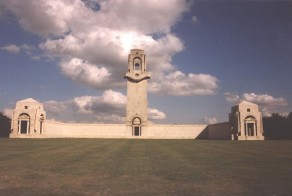Identified Casualties
10770
Visiting Information
19.04.2004 PLEASE NOTE: Doubts about the structural condition of the balustrade and steps leading to the viewing platform of the Villers-Bretonneux Memorial have resulted in its closure pending further investigation. Visitor access to the commemorative panels should not be affected. We apologise for any inconvenience caused to visitors during this time. Wheelchair Access to the cemetery is possible, but may be by alternative entrance. For further information regarding wheelchair access, please contact our Enquiries Section on 01628 507200. The names are engraved on the memorial in order of battalion, then alphabetically under rank.
Local Information
Villers-Bretonneux is a village 16 kilometres east of Amiens on the straight main road to St Quentin. The Memorial stands in Villers-Bretonneux Military Cemetery, which is about 2 kilometres north of the village on the east side of the road to Fouilloy.
Historical Information
Villers-Bretonneux became famous in 1918, when the German advance on Amiens ended in the capture of the village by their tanks and infantry on 23 April. On the following day, the 4th and 5th Australian Divisions, with units of the 8th and 18th Divisions, recaptured the whole of the village and on 8 August 1918, the 2nd and 5th Australian Divisions advanced from its eastern outskirts in the Battle of Amiens. The VILLERS-BRETONNEUX MEMORIAL is the Australian national memorial erected to commemorate all Australian soldiers who fought in France and Belgium during the First World War, to their dead, and especially to those of the dead whose graves are not known. The 10,770 Australian servicemen actually named on the memorial died in the battlefields of the Somme, Arras, the German advance of 1918 and the Advance to Victory. The memorial was unveiled by King George VI in July 1938. The memorial stands within VILLERS-BRETONNEUX MILITARY CEMETERY, which was made after the Armistice when graves were brought in from other burial grounds in the area and from the battlefields. Plots I to XX were completed by 1920 and contain mostly Australian graves, almost all from the period March to August 1918. Plots IIIA, VIA, XIIIA and XVIA, and Rows in other Plots lettered AA, were completed by 1925, and contain a much larger proportion of unidentified graves brought from a wider area. Later still, 444 graves were brought in from Dury Hospital Military Cemetery. There are now 2,141 Commonwealth servicemen of the First World War buried or commemorated in this cemetery. 608 of the burials are unidentified but there are special memorials to five casualties known or believed to be buried among them, and to 15 buried in other cemeteries whose graves could not be found on concentration. The cemetery also contains the graves of two New Zealand airmen of the Second World War. Both cemetery and memorial were designed by Sir Edwin Lutyens.
Memorial Photo
Click the thumbnail below to view a larger image.

CWGC War Memorial Photo: VILLERS-BRETONNEUX MEMORIAL
Memorial Plan






